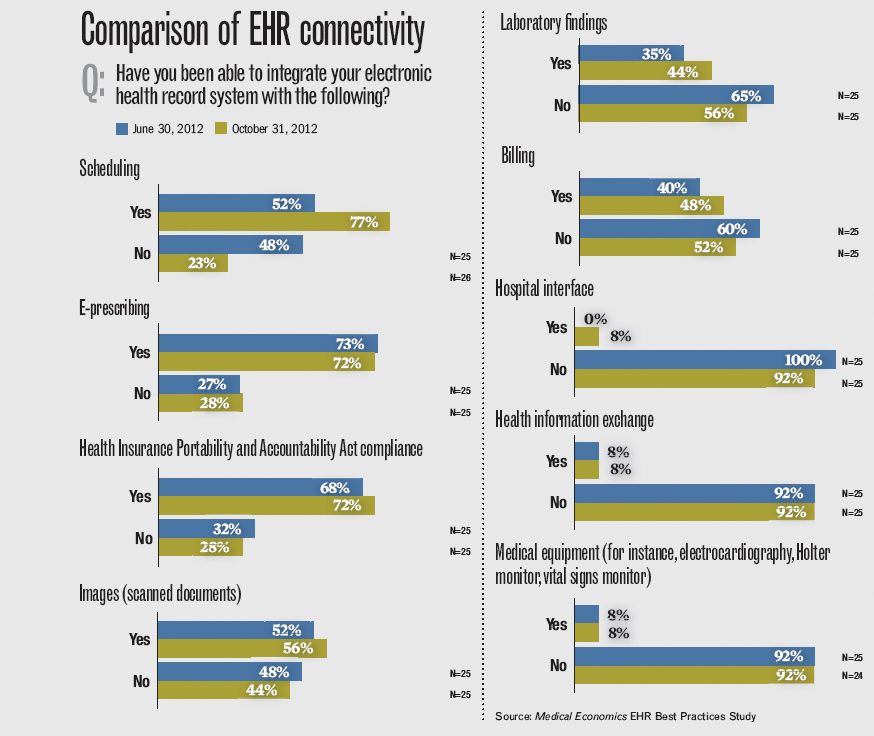Article
EHR integration is growning-for the most part
A look at Medical Economics' EHR Best Practices Study shows that integration is continuing, but room for improvement still exists.
Medical Economics’ latest survey of the primary care physicians (PCPs) involved in the EHR Best Practices Study reveals that they are continuing to integrate their internal systems with their patients’ electronic health records (EHRs).
Connectivity between the EHRs and scheduling, billing, e-prescribing, laboratory, and imaging systems all show marked increases. In addition, integration with systems designed to maintain and enhance compliance with the Health Insurance Portability and Accountability Act also has increased.
As can be seen in the graphs on the opposite page, however, health information exchange continues to lag far behind other types of EHR integration and connectivity, as does the development and implementation of hospital interfaces. Does this status indicate a simple lack of interest in health information exchange and hospital interfacing among PCPs, or are bigger forces at work?
Myths exposed

In a blog post titled “The myth of hospital integration,” Robert Rowley, MD, a practicing PCP for 30 years and an early EHR developer, notes that of all the system integrations expected of independent physicians today, integrating with a local hospital is the most crucial and the most challenging.
“Most hospitals, not surprisingly, did not get to meaningful use via a single overall piece of software,” he says. “Usually, it was a collection of elements that, together, could achieve the needed performance. Even large institutions with robust information technology infrastructure needed to do that.”
According to Rowley, that situation accounts for much of the anecdotal “evidence” of failed EHR installations. Hospitals are engrossed in attempting to “knit together” all their disparate systems into one cohesive unit. That, or they’re already looking to “rip and replace” their older existing system with an integrated “modern” system that’s designed from the start for enterprise-wide connectivity.
Either way, Rowley says this reality explains why developing hospital interfaces for local practices and supporting health information exchange is a low priority, even though those goals are a high priority for practices attempting to establish hospital connectivity, exchange health data, and attest to meaningful use.
“The bottom line is that ‘hospital connectivity’ is really a bit of a myth.” Rowley says. “Each kind of connection, whether it be medical records, labs, imaging, or pharmacy, is really a separate integration, using different standards and methods.
“Small wonder that many hospitals are willing to ‘integrate’ by simply extending their in-house system to closely allied [or owned] community physician [practices] but are not willing to create interfaces with multiple other systems,” he adds.
To establish connectivity with your local hospital, Rowley recommends looking at the hospital as a “collection of data systems” to try to connect with individually rather than all at once.
“Given the complexity of ‘connecting to my local hospital,’ it is likely to be a long time before a systematic way of tying it all together is seen in this country,” he says. “Each hospital has its own unique internal integration issues and is unlikely to be able to connect externally very well.”
With more than 5,700 registered hospitals in the United States (according to the American Hospital Association), Rowley adds, a scalable, universal solution is not likely to be achieved any time soon. “However, we can start building connectivity now. It involves different and innovative approaches to data exchange that are not reliant on a ‘universal [health information exchange]’ structure to be built.”

Send your feedback to medec@advanstar.com. Also engage at www.twitter.com/MedEconomics and www.facebook.com/MedicalEconomics.





